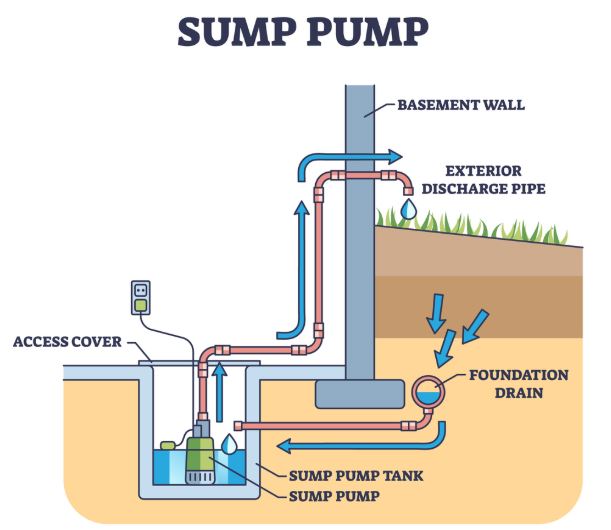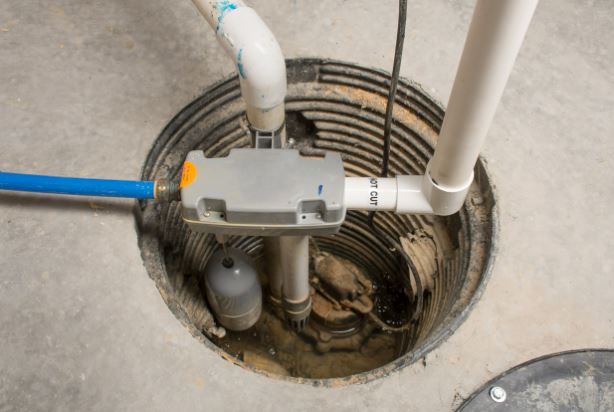What Is a Sump Pump? How a Sump Pump Works

Depending on where you live, a sump pump is absolutely essential, but what is a sump pump, and how does it work? We’ll teach you what you need to know about sump pumps, including how to maintain one to ensure it’s working properly at all times.
When your sump pump needs a professional fix, you can call YES! to get high-quality plumbing service.
What Is a Sump Pump?
A sump pump is a submersible device in a basement or under a house. The purpose of a sump pump is to prevent a basement from flooding by moving water outside the house.
The benefits of using a sump pump include preventing water damage, saving you thousands, preventing mold development, and pest infestations.
How Does a Sump Pump Work to Get Rid of Water from a House?
While describing how a sump pump works seems simple, it’s actually a complex process. A sump pump is made up of three parts.
The Sump Pump
This is the main machine that pulls water from the sump pit and pushes it out to the discharge line. A pump has a float switch that activates the pump once water reaches it, preventing the pit from overflowing.
Once activated, the electric motor powers the impeller, a device that spins rapidly like a fan. The impeller pulls the water up and toward the discharge line.
When the water level drops to a certain level, the sump pump turns off until it is needed again.
The Sump Pit
Water pools into the sump pit to prevent the spread of water throughout the basement. It’s set up at the lowest point of a basement or under a house. It’s usually a couple of feet deep and has gravel at the bottom to keep it from tipping over (if not built into the floor).
Discharge line
The discharge line takes water from the sump pit and releases it somewhere else outside. A special check valve closes the line to prevent water from coming back through it.
Where Should the Discharge Line Be Pointed?
Ensuring that the other end of the discharge line is in the right place is crucial to prevent the water from returning to your home. When deciding where to point the discharge line, consider:
-
The slope of your yard: If your yard slopes toward your home, you want to make sure the line is above the slope. If you don’t, the water will just flow down. If your yard slopes away from your house, the discharge line should be at the top of the slope for easy flow down.
-
Saturation of your yard: If your yard can’t absorb much water, which can happen due to soil composition or the grade of your land, you want to push the water toward the street to prevent flooding and possible pest infestation.
-
Where the water will end up: You don’t want to direct your discharge line where it could cause trouble, such as toward your neighbor's yard. It’s best if the water flows toward the street, where it would drain into the sewers.
-
Regulations: There may be special regulations for your city about where you are allowed to discharge water.
Sump Pump Maintenance Tips
Maintaining your sump pump is crucial, even if you only use it once a year. You never want your pump to stop working when you need it the most—though we do offer emergency services for that type of situation.
-
Regularly check the power: You never know if there is an electrical issue with your sump pump.
-
Clean your sump pump: Clear your pump of any debris using a garden hose or wire brush, depending on how dirty the pump is. This should also include ensuring the discharge line is free of clogs. (Make sure to unplug your pump before cleaning it.)
-
Inspect the check value: Make sure the check valve still functions as it should and doesn’t need lubrication. Don’t forget to turn it back to the proper position when you’re done.
-
Test your pump: After doing all this, pour water into your pump to make sure it’s working correctly. This will also let you know if your float switch is working properly.
Call to schedule a maintenance appointment today!
4 Signs That You Need to Repair or Replace Your Sump Pump

Along with maintenance, it’s important to know when to replace or repair your sump pump. Again, you never want to find out it’s not working right when you need it.
-
Age
How long do sump pumps last? Around 10 years. They don’t work as well as they age; eventually, they need to be replaced. A YES! technician will tell you if it’s time for a replacement if you have regular maintenance appointments.
-
Noisy
Even while working, sump pumps should be relatively quiet. If you notice that your sump pump is loud and making grinding, rattling, or knocking noises, that means something is wrong. Turn off your pump and inspect it. It could simply be a matter of cleaning it, or it could be something more complex that requires a professional.
-
Always Running
As we mentioned before, the float switch should prevent the pump from always being on, so you need to figure out what’s wrong if it's running all the time. There could be something wrong with the float switch or the electrical system.
-
Visible Rust
Any sign of rust means that corrosion is occurring; this will need a deep clean and potential part replacement. Rust could break the various internal components within the pump and ruin the whole system.
Does Every House Have a Sump Pump?
No, not every house needs a sump pump. Homes in areas with low flood risk or on elevated land are less likely to flood.
Do Utah Homeowners Need a Sump Pump?
Yes, most Utah homeowners need a sump pump due to the potential snowmelt floods, flash floods, and the general rainy season. A sump pump will save you a lot of heartache and prevent water damage if you live in:
-
Ogden
-
Marriott-Slaterville
-
Provo
-
Pleasant Grove
-
Kaysville
-
Midvale
-
Springville
-
Payson
-
Price
If you don’t have a sump pump, schedule an appointment in Utah today and YES! technicians will get it all set up.
Do Nevada Homeowners Need a Sump Pump?
Yes, despite appearing like a desert, Nevada is prone to flooding—especially during monsoon season. Without a sump pump, your basement may flood.
Nevada homeowners should have a sump pump installed if they live in:
-
Rhodes Ranch
-
Columbus
-
Mansfield
-
Maysville
-
Dayton
-
Wilmington
-
Muncie
-
Marion
-
Seymour
Schedule an appointment with YES! in Nevada to get a sump pump installed before you need it.
Sump Pumps Are a Vital Part of Your Home
A sump pump can prevent your home from flooding and the water damage that comes along with it—as long as it’s working. Save yourself stress and thousands of dollars in replacing damaged items by installing, maintaining, and repairing a sump pump.
Luckily, YES! has decades of experience serving Utah and Nevada homeowners and their sump pump needs.
